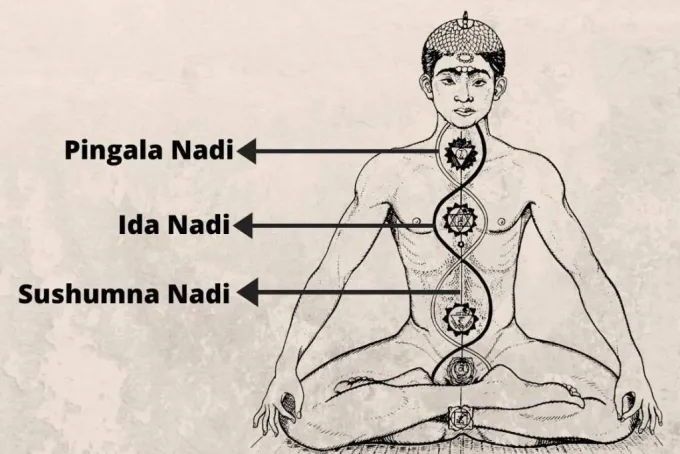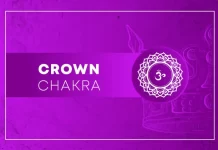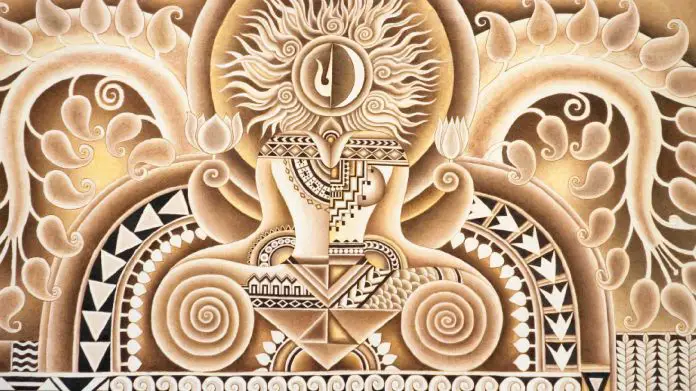Main Nadis similar to show energy goes via your nervous system, our astral body has hundreds of energy pathways called nadis.
All living things, according to traditional medical practices like Ayurveda and yoga, are nourished by their own life energy, or prana. Prana can move freely throughout the body thanks to the Nadis, which are channels.
The Nazis must be unblocked and in good condition. Your physical and mental health care is impacted when the Nady system is hampered.
This page will describe several significant nadis, including Ida, Pingala, and Sushumna, and what they play in the yogic system.
Demystifying Main Nadis
The Sanskrit root word “Nada,” which means “to flow,” is where the word “Nadi” first appeared. If we take a literal interpretation, it also refers to a river or a river that is flowing.
In our body, Nadis are the network of energy channels that facilitate Prana’s movement in the body’s different organs. Prana is the vital force or life energy that every living being has.
Nadis function similarly to a tube or pipe through which water flows smoothly. Similar to how our apparent veins convey blood through our circulatory system, the nadis are thought to be subtle conduits that transmit energy throughout our existence.
The pranic, mental, and spiritual energies known as nadis form a matrix that runs through the physical body. Through their massive network, which moves prana in all directions, they give power to each and every cell and organ in the body.
A nerve impulse occurs in the physical body on a gross level, much like how “Prana” moves through nadis in the subtle plane. Nadis, which are not to be confused with nerves, are the body’s energy pathways. Nadis can only be seen as energy and consciousness in motion during the deep and higher states of meditation because nerves serve as the physical body’s carriers in anatomical studies.
Kundalini Shakti is meant to awaken through Nadis, and many yoga schools such as Raja Yoga, Hatha Yoga, and Kundalini Yoga all strive to achieve this. The only time these Nadis can flow with Kundalini shakti is when they have been cleaned.
How many nadis are there in our body?
Due to the size and complexity of the Nadi network in our bodies, various numbers of nadis have been listed in ancient manuscripts.
350,000 Nadis make up our body, according to Shiva Samhitha.
There are 300,000 Nadis in the human body, according to another scripture called the Prapanchasara Tantra.
Goraksha Samhita and Hatha Yoga Pradipika highlight the total number of Nadis is 72,000 and they arise from Nadi Kanda. Nadi Kanda is the ‘bird egg’ shaped root situated below to umbilicus and above the pubis.
Out of 72000 nadis, 14 nadis have been identified as important ones. They are:
- Ida – Known for its feminine and cool energy, it starts at the Muladhara and ends at the left nostril. It is also associated with the energy of the moon.
- Pingala – Known for its masculine and heating energy, it flows on the right side and ends at the right nostril. It is also associated with the energy of the sun.
- Sushumna – The main or central Nadi through which the prana flows to the other nadis. It starts at Muladhara and ends at the Sahasrara chakra.
- Gandhari – It is responsible for providing energy to the left eye. It starts at the Muladhara and ends at the Ajna Chakra.
- Hastijihva – Gives energy to the left limbs, i.e., the left arm and leg. This Nadi starts at Muladhara and ends at the Manipura Chakra.
- Kuhu – Provides energy to the genitals. It starts at Muladhara and ends at the Svadhisthana Chakra.
- Saraswati – Responsible for giving energy to the throat, mouth, and tongue. It starts at Muladhara and ends at the Vishuddhi chakra.
- Pusha – Gives energy to the right eye. It starts at the Muladhara and ends at the Ajna chakra.
- Shakhini – Gives energy to the left ear. It starts at the Muladhara and ends at the Ajna chakra.
- Payaswini – A complimentary Nadi to the Pingala, it flows through the Saraswati and Pusha Nadi and ends at the right ear.
- Varuni – Provides energy to the whole body through the nervous system. Begins at the Muladhara and ends at the Anahata chakra.
- Alambusha – Provides energy to the organs responsible for the elimination of waste. It starts from the anus and ends at the mouth, moving through the Muladhara Chakra
- Vishwodari – Gives energy to the organs related to the digestive system. It starts at Muladhara and ends at Manipura Chakra.
- Yashaswini – Provides energy to the right libs, i.e, right arm and leg. It starts at Muladhara and ends at Manipura Chakra.
3 Main Nadis – Ida, Pingala & Sushumna

From the above 14, the Ida, Pingala, and Sushumna are of utmost importance and move through the spinal cord and chakras. These 3 main Nadis are termed Trividha Nadi. Shiva Samhitha states that in between Trividha Nadi, there is a Nadi in a subtler form called Chitra Nadi.
Trividha Nadi or 3 main nadis are situated near the spine, resembling the stalk of a lotus facing downwards (Adhomukha Padma).
Ida Nadi is situated towards the left side and Pingala Nadi is towards the right side of Sushumna Nadi. Ida and Pingala nadis spiral around the Sushumna Nadi resembling the double helix of human DNA. They cross each other at certain points along the spine, forming Chakras.
Ida, Pingala, and Sushumna Nadi meet at Triveni point which is situated at Ajna Chakra, midway between the eyebrows. Later Ida Nadi terminates at the left nostrils whereas Pingala Nadi terminates at the right nostrils.
1. Ida Nadi
Ida Nadi is also known as Chandra Nadi because it represents the planet moon (Chandra tattva). Ida, which is Sanskrit meaning comfort, accounts for Ida Nadi’s chilly temperament and capacity to nurture both body and soul. It drives emotions and regulates all mental functions. It is in charge of our personality’s feminine, lucky, and effortlessly fluid actions.
Ida Nadi’s fundamental traits include introspection, self-reflection, artistic expression, coolness, passivity, receptivity, restfulness, and sensitivity.
The Ida Nadi has anabolic properties, and its operations and the parasympathetic nervous system may be connected (rest and digest system). It controls speech that is inspired or prophetic.
Strong Ida energy tends to be associated with nurturing and perceptive traits. They might not have the boldness, lucidity, or self-assurance needed to acquire worldly knowledge, though.
It is associated with right-brain dominance, which is thought to encourage creativity and artistic ability, and it finishes in the left nostril.
Ida Nadi mainly operates throughout the night-time which results in a slow metabolism and a sense of relief the night. However, sometimes the activity of Ida can also relate to tamas qualities.
Symptoms of Blocked Ida Nadi
When Ida Nadi is blocked, the person will experience emotional instability, fatigue, and despair. You can spot blocked Ida Nadi by looking for these signs:
- Feeling restless in the night
- Improper digestion
- Hypothyroidism
- Increase in gas and flatulence
- High susceptibility to diabetes
- Epilepsy seizure, dementia, depression, and mental health problems
- Not being able to correct bad habits
- Low assertiveness, passive behavior
Unblocking the Ida Nadi
Pranayama such as Nadi Shodhana and Surya Bheda Pranayama can be effective in clearing away blockages and imbalances of the Ida Nadi. Practicing hatha yoga can also bring about a significant change as the term “hatha yoga” literally means “sun-moon yoga,”.
2. Pingala Nadi
It also goes by the name Surya Nadi because it represents the Sun (Soorya tattva). The word “Pingala” in Sanskrit means “orange” or “tawny.” Pingala Nadi, in contrast to Ida, is warm, energetic, and stimulating in character, sustaining body warmth as a result.
Pingala Nadi, which terminates in the right nostril and is supposed to promote analytical, logical, and systematic reasoning, is connected to left-brain dominance.
Pingala Nadi controls all critical somatic processes, promotes body growth, engages in catabolic activity, and has potential associations with the sympathetic nervous system (fight or flight system). It represents the Raja’s guna and controls more of the more masculine facets of our personalities.
People with strong Pingala energies tend to have Type A personalities and to be direct, outspoken, and creative. However, they could not possess the lunar traits that are essential for spiritual awakening, like empathy, perception, and self-awareness.
The mind and senses are extroverted with the supremacy of physical energy in our body when the Pingala Nadi flows in dominance, the breath will be warm and more in the right nostril. The left hemisphere, the frontal lobe, and the right side of the body are all influenced by Pingala Nadi.
Symptoms of Blocked Pingala Nadi
When Pingala Nadi is blocked, it has an impact on the person by causing them to act more aggressively, become more domineering, and possibly ruin relationships. A blocked Pingala might also result in.
- Overeating, increased appetite, and cravings for junk food
- Acidity, ulcers
- Hyperthyroidism
- Fever
- Dryness in the skin and throat
- Bronchitis and arthritis
- Improper kidney and liver functioning
- Getting frustrated easily, feeling irritated, and having aggressive nature
- Increased levels of testosterone and estrogen – High sexual drive
Unblocking the Pingala Nadi
Blockages can be removed and the Pingala Nadi can be opened with the help of pranayama techniques like Nadi Shodhana and Chandra Bhide Pranayama. Hatha yoga, which literally translates to “sun-moon yoga,” can also result in major changes.
The Ida and Pingala stand for the fundamental dual life. It can also be referred to as your logical and intuitive sides, or simply as masculine and feminine.
Ida Nadi energy should be balanced by rational and linear Pingala energy. You can overcome obstacles in life and become more productive by bringing Ida and Pingala into balance.
Contrary to what we typically think, a person does not typically breathe simultaneously via both nostrils. Every 90 minutes, our breathing cycles switch between our left and right nostrils, or Ida and Pingala.
When the left nostril flows, it means that the Pranic energy, or Pingala Nadi, is weak and the mental energy, or Chitta, is predominant. The Pranic powers are stronger and the mental aspect is weaker when the right nostril is flowing.
The hemispheres of the brain can also be used to evaluate Ida and Pingala Nadi. Ida is represented by the right hemisphere, which is where mental processes occur. Pingala, which is where crucial processes take place, is represented by the left hemisphere.
A feeling of serenity comes from the Nadi cleaning. Because of your persistence and self-assurance, the results are frequently satisfying. because the left and right brains are no longer competing for control of the thoughts.
3. Sushumna Nadi
In the Shiva Samhita, Sushumna is referred to as “a source of immense bliss.” Sushumna is a term used to describe a calm, balanced prana flow as well as a harmonious state of the autonomic nervous system. In a nutshell, Sushumna is the contemplative state.
Sushumna Nadi is situated at the center of the spinal cord in between Ida and Pingala Nadi. It’s considered to be the most gracious, spiritual, and hidden channel like the river Saraswathi originating at the base of the spine (Muladhara Chakra).
Because it enables yogis to experience spiritual enlightenment, this primary channel is also known as Brahma Nadi—the road to Brahman or the supreme being. When our prana passes through the Sushumna Nadi for a considerable amount of time, we depart from the physical world and enter a state of samadhi.
From the base of the spine (Muladhara chakra) to the top of the head, the Sushumna Nadi travels (Sahasrara chakra). Kundalini energy rises in this manner from the base of the spine to the crown of the skull. It is considered to be the primary pathway for prana to travel throughout the body. It links every chakra in the body.
When Kundalini Shakti at Muladhara Chakra is awakened from the dormant state, it moves through Sushumna Nadi to reach Sahasrara Chakra. It passes through all 6 Chakras through its path where we find 6 various Shakti like Daakini, Haakini, Kaakini, Laakini, Raakini, and Shaakini.
Moreover, the tongue in Khechari mudra is used to tap the top of Sushumna Nadi to facilitate these Shakti.
In Guna’s perspective, Sushumna Nadi is called Trigunamayi means it comprises all the 3 Gunas (qualities), representing the sun, moon, and fire altogether. When the Sushumna Nadi is balanced and dynamic, it is said that we achieve true harmony within ourselves and are fully attuned to the Divine.
How to activate Ida, Pingala, and Sushumna

The initial purifications or Shatkarma, mudras, visualization, pranayama, and mantra chanting all work together to drive prana to flow from the Ida and Pingala channels into the central Sushumna channel. The mudras especially seal up numerous openings, capturing prana and channeling it into the Sushumna.
The flowing of the active Nadi lasts for 60 minutes, according to the Shiva Swarodaya scripture. After that, Sushumna functions for a further 1-4 minutes before the other Nadi starts to work.
Sushumna can be stimulated from its dormant state via chakra meditations, allowing kundalini energy to ascend and spiritual awakening to occur. Prana energizes and activates dormant energy as it continues moving up the Sushumna Nadi, energizing all of the chakras along the way.
Similarly, as a technique of opening and stimulating Sushumna, Nadi Shodhana pranayama can help to balance the Ida and Pingala nadis.
Conclusion
Different types of Nadis are dominant in various stages of life, right from birth in all humans. Yoga leads to the union of the individual soul with the universal soul. It can be achieved by harnessing the vital energy present within the body, moving through various channels.
It is necessary to look deeply into oneself and into the mysteries of the mind and subtle body to reach the ultimate goal of enlightenment. By proper yoga practices under a good teacher, the person can awaken the Sushumna Nadi to maintain health and attain salvation which is the ultimate purpose of Yoga.





















